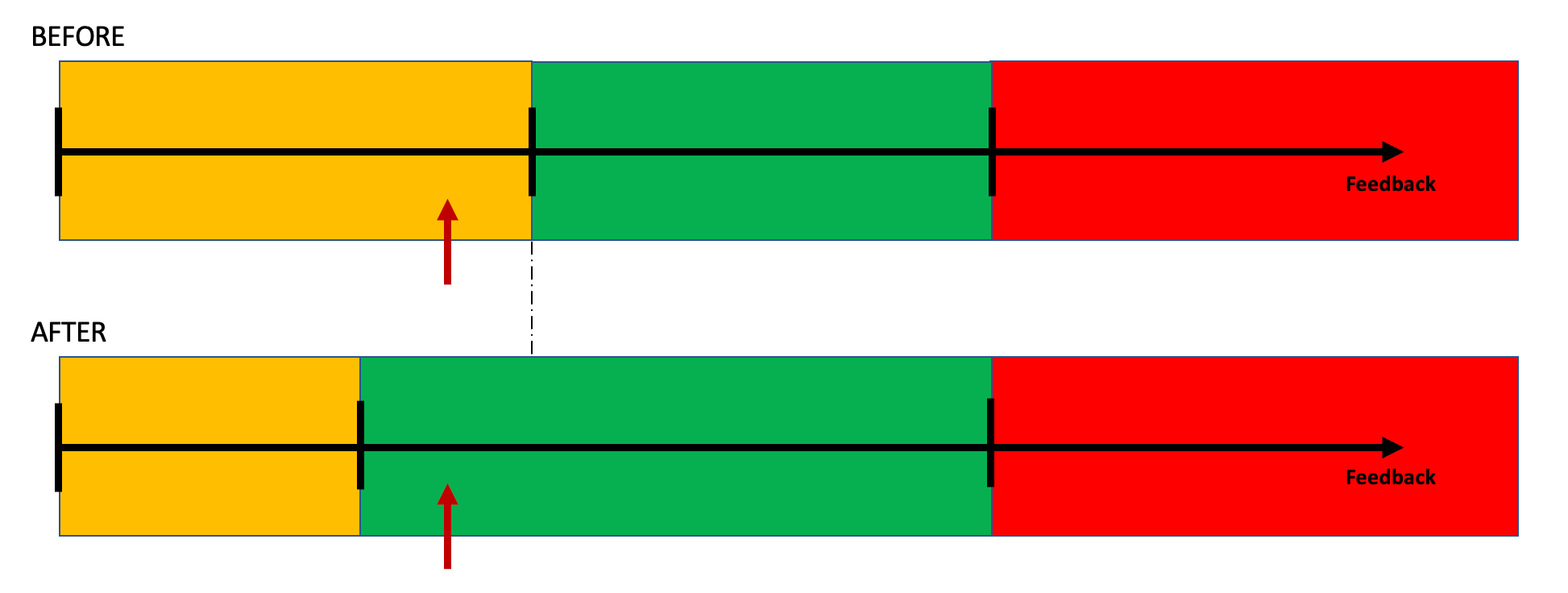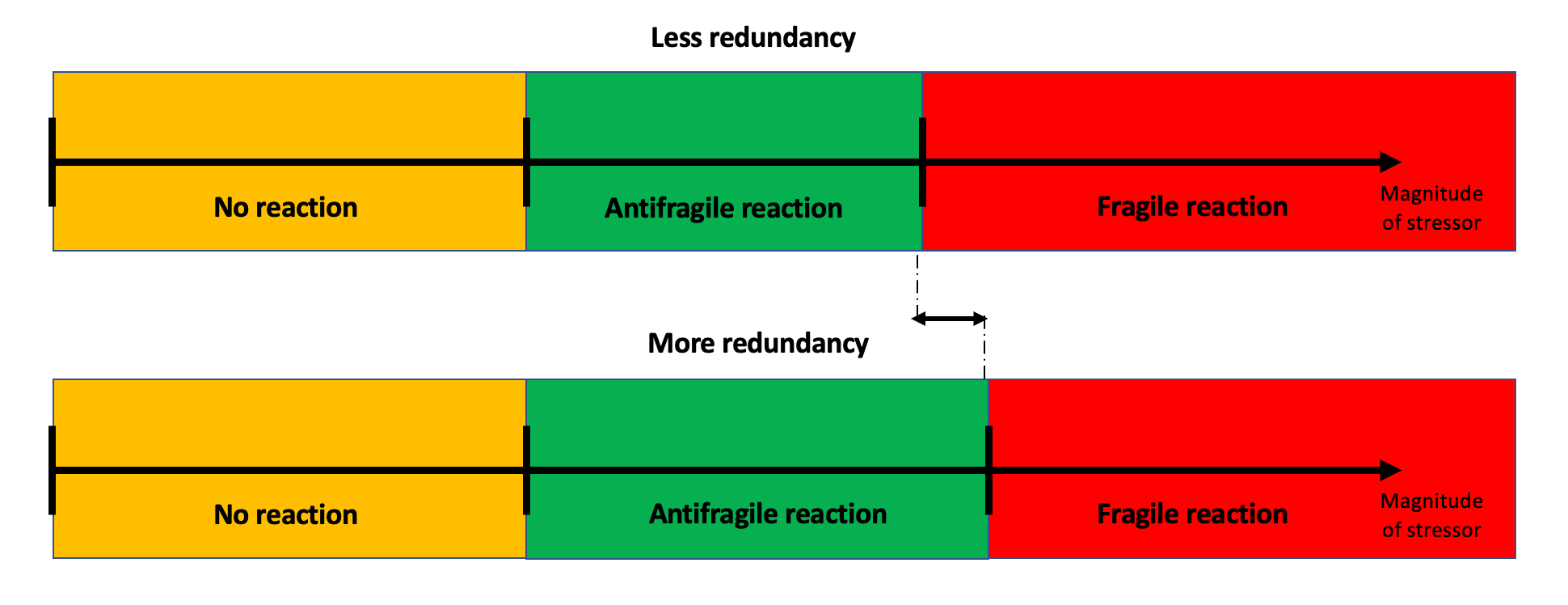The Dellanna Diagrams
A visual framework to understand antifragility and how to grow your capacity to benefit from problems.
Published: 2024-06-24 | Last updated: 2026-01-09 by Luca Dellanna
People are antifragile. It’s a concept first defined by Nassim Nicholas Taleb in his homonymous book, and it describes what benefits from problems and variation.
To facilitate the understanding of this complex topic, I created a simple visual tool, which my students came to call the Dellanna Diagram.

For example, this muscle describes the reaction of our muscles when we lift weights:
- If the weights are light, we lift them effortlessly, but nothing happens. We are in the yellow area.
- If the weights are heavy, we lift them with some effort, which triggers biological mechanisms that grow our muscles and make us stronger. We are in the green area.
- If the weights are too heavy, we injure ourselves. We are in the red area.
This diagram applies to almost every reaction people have to external stressors, problems, and feedback.
As another example, imagine your manager at work assigns you an objective:
- If the objective is too easy, you don’t learn anything. You are in the yellow area.
- If the objective is moderately hard, you learn something from it and become a better employee. You are in the green area, and that’s an antifragile reaction.
- If the objective is too hard, you might get frustrated and lose motivation, or you might even fail and lose your boss’ trust. You are in the red area, and that’s a fragile reaction.
The Dellanna Diagram is a useful tool for understanding how to become more antifragile.
Before explaining this, let me clarify a common misunderstanding. Antifragility is not the ability to merely survive problems or variations but to benefit from them.
Principle
Antifragility is not the ability to merely survive problems or variations but to benefit from them.
This is very important because if you merely aim to make yourself or your organization robust to problems, you will promote behaviors that leverage rigidity – a property that decreases antifragility. In fact, a rigid person or organization wants to minimize and avoid problems, whereas antifragile people and organizations do the opposite: they proactively surface problems in order to adapt to them.
Creating engagement
It might seem like the Dellanna Diagram of disengaged students and disengaged employees looks like the one below: problems are either too easy, triggering complacency (the yellow area), or too hard, triggering paralysis or frustration (the red area).

However, their actual diagram is like the one below. There is a green area. It’s just so small that it looks like it’s not there.

Great teachers and great managers excel at finding the right problem to give to their disengaged students and employees, hitting them in the green area and triggering antifragility, progressively growing their skills and motivation until they become skilled and engaged.
If you are not convinced it’s possible, think about a 50-year-old person living a sedentary lifestyle. If they suddenly start going to the gym, they might believe that their body’s Dellanna Diagram only has a yellow and a red area: the weights they lift are either too light to create any muscle gain or too heavy to create pain and injury.
However, even for them, there is a right size of weights to lift that is heavy enough to hit them above after the yellow area and before the right one, triggering muscle growth but not an injury. That’s the green area.
And if they do find that size of weights and lift them, they trigger antifragility and get stronger, which means that they grow the range of weights that they can safely lift.
They grow their green area.
Becoming more antifragile
The Dellanna Diagrams are useful because they help you understand how you can become more antifragile.
How do you grow the green area?
Easy: by shifting the threshold between the yellow and the green area to the left or by shifting the threshold between the green and the red area to the right. Let’s see what that means.
Shifting the threshold between the yellow and the green area to the left means that problems that previously hit you in the yellow area and were ignored now hit you in the green area and trigger adaptation and strengthening. This means you start adapting to smaller problems.
Fragile organizations do not start adapting to problems until the problem is large enough to become a priority – at which point, it is usually too late.
Conversely, antifragile organizations understand that problems grow to the size they need for you to acknowledge them, so they proactively surface small problems and adapt to them before it is too late.
Shifting the threshold between the green and red areas to the right means that problems previously hitting you in the red area and causing failure now hit you in the green area instead, triggering adaptation and strengthening. This means making yourself more resilient to large problems.
Fragile organizations overoptimize their investments, ending up with too little balance and resources to face unexpected problems.
Conversely, antifragile organizations understand that you can only adapt to problems you survive and that long-term efficiency requires capping short-term efficiency. Therefore, they always keep more resources than they need and never get into situations that might become dangerous in case of unexpected changes.

In the video below, I explain in greater detail what this means concretely, both for individuals and for organizations.
The way forward
I hope this introduction to antifragility and the Dellanna Diagrams helped you.
I frequently advise on how to make individuals and organizations more antifragile. If you have any questions or are interested in working with me, feel free to email me.
For a deeper dive into how irreversibility affects decision-making, see my post on ergodicity economics.